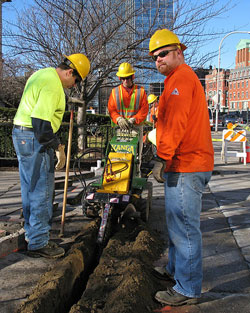There’s a narrative circulating that our infrastructure is failing. While this might be true in some areas, a massive construction project is currently underway to create a robust fiber optic network across the nation. This “nervous system” for information technology promises practically limitless, low-lag bandwidth for the foreseeable future.

This surge in fiber optic infrastructure isn’t driven by failing systems, but rather by existing infrastructure reaching full capacity. The late 20th century witnessed a fiber optic boom, which initially seemed excessive when the tech bubble burst. It’s taken over a decade to fully utilize that initial wave of fiber optic cable. While some underused fiber rings still exist, burgeoning demands from business process automation, high-frequency financial services, electronic medical records, and 4G wireless, among others, necessitate expansion.
Allied Fiber, along with its Dark Fiber Community, is tackling this challenge. Rather than a carrier, Allied Fiber functions as an infrastructure developer, providing carriers with new, unlit fiber routes. Notably, AboveNet, a premier fiber optic carrier, has partnered with the Dark Fiber Community, contributing its expertise in high-performance fiber optic networking to this massive undertaking.
The Dark Fiber Community, an alliance of over 60 members, including equipment suppliers, carriers, industry groups, financing firms, and other stakeholders, serves as an online hub. Hosted by TMCnet.com, it provides resources and an educational platform to bolster Allied Fiber’s mission.
Allied Fiber is constructing and leasing a vast national dark fiber optic backbone. This network will form a ring, connecting major US cities including New York City, Chicago, Seattle, Los Angeles, Phoenix, Dallas, Houston, Jacksonville, Miami, Ashburn, VA, and back to NYC. The route essentially traces a circle around the contiguous United States.
Allied Fiber’s ingenious design goes beyond simple long-haul routes between these major cities. The system comprises two parallel routes: one for long-haul connections between major cities, and a second divided into 60-mile segments. These shorter segments terminate in colocation facilities, where laser signals are amplified for the next leg. The facilities also house multiplexing equipment, enabling network services to be added or dropped along the route. This long-haul/short-haul approach allows Allied to deliver low-latency fiber between major cities while maintaining the ability to serve numerous locations along the route and connect to other short-haul lines branching off the main path.
One application of this system will be Fiber to the Tower (FTTT). While FTTT may not be a familiar term yet, it will soon become commonplace. The wireless industry is rapidly transitioning to 4G, but its current copper-based backhaul infrastructure is bandwidth-constrained. This necessitates new fiber optic connections to many cellular base stations. Allied’s FTTT strategy involves providing access to duct fiber every 1 to 2 miles, facilitating lateral extensions from the main fiber route to tower locations.
If you require high-bandwidth fiber optic services at competitive prices, you might have more choices than you realize. Explore your options by requesting pricing and availability for dark and lit fiber optic bandwidth services.
Note: Photo of workmen installing fiber optic cable courtesy of Paul Keleher on Wikimedia Commons.

